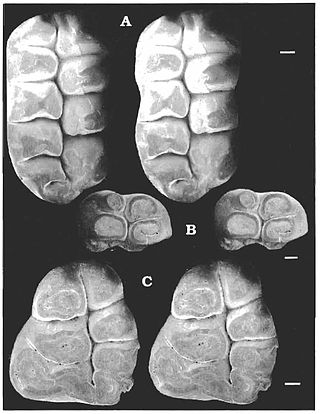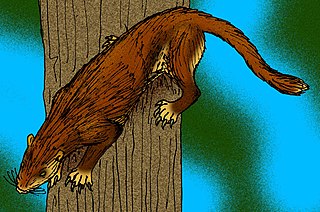Related Research Articles

Catopsalis is a genus of extinct mammal from the Paleocene of North America. This animal was a relatively large member of the extinct order of Multituberculata. Most Multituberculates were much smaller.
Sphenopsalis is a genus of extinct mammal from the Paleocene of Central Asia. It was a member of the extinct order Multituberculata, and lies within the suborder Cimolodonta and the superfamily Taeniolabidoidea. The genus was named by William Diller Matthew, W. Granger and George Gaylord Simpson in 1928.

Taeniolabis is a genus of extinct multituberculate mammal from the Paleocene of North America.
Neoplagiaulax is a mammal genus from the Paleocene of Europe and North America. In the case of the latter continent, there may possibly be some slightly earlier, Upper Cretaceous material too. It existed in the age immediately following the extinction of the last dinosaurs. This animal was a member of the extinct order Multituberculata, lying within the suborder Cimolodonta and family Neoplagiaulacidae.
Parectypodus is an extinct genus of mammals that lived from Late Cretaceous (Maastrichtian) to Eocene time in North America. It is a member of the extinct order of Multituberculata, suborder Cimolodonta, family Neoplagiaulacidae. It was named by G.L. Jepsen in 1930.
Kimbetohia is a genus of mammal belonging to the extinct order Multituberculata. It lived from the Upper Cretaceous to the Paleocene period in the United States.
Eucosmodon is a genus of extinct mammal from the Paleocene of North America. It is a member of the extinct order of Multituberculata within the suborder of Cimolodonta, and the family Eucosmodontidae. This genus has partly also been known as Neoplagiaulax. All known fossils of this small mammal are restricted to teeth.
Microcosmodon is a mammal genus from the Paleocene of North America. It was a member of the extinct order Multituberculata, and lies within the suborder Cimolodonta and family Microcosmodontidae. The genus Microcosmodon was named by G.L. Jepsen in 1930.

Alphadon is an extinct genus of small, primitive mammal that was a member of the metatherians, a group of mammals that includes modern-day marsupials. Its fossils were first discovered and named by George Gaylord Simpson in 1929.

Bryanictis is an extinct genus of placental mammals from extinct subfamily Didymictinae within extinct family Viverravidae, that lived in North America, from the early to late Paleocene.
The Evanston Formation is a geological formation in Wyoming whose strata date back to the Late Cretaceous. Dinosaur remains are among the fossils that have been recovered from the formation. The fossil formation also has the remains of prehistoric mammals from the Paleocene epoch.

The Nacimiento Formation is a sedimentary rock formation found in the San Juan Basin of western New Mexico. It has an age of 61 to 65.7 million years, corresponding to the early and middle Paleocene. The formation has yielded an abundance of fossils from shortly after the Cretaceous-Paleogene extinction event that provide clues to the recovery and diversification of mammals following the extinction event.

Hyopsodontidae is an extinct family of primitive mammals from the order Condylarthra, living from the Paleocene to the Eocene in North America and Eurasia. Condylarthra is now thought to be a wastebasket taxon; hyopsodontids have occasionally been speculated to be related to Afrotheria, but the most recent consensus is that they are related to Perissodactyla. Analysis of the inner ear shows shared characteristics with the Equoidea ; they may be a basal ungulate group near to perissodactyls.

Eoconodon is an extinct genus of triisodontid mesonychid that existed during the early Paleocene of North America. Characteristics of the genus include massive jaws, blunt builds, and strong canine teeth.
Chacomylus is an extinct genus of odd-toed ungulate condylarth which existed in the Nacimiento Formation, United States during the early Paleocene period. It was first named by Thomas E. Williamson and Anne Weil in 2011 and the type species is Chacomylus sladei.
Chacopterygus is an extinct genus of cimolestid mammal which existed in New Mexico, during the early Paleocene. Its fossils have been recovered from the Nacimiento Formation, San Juan Basin, New Mexico. It was first named by Thomas E. Williamson, Anne Weil and Barbara Standhardt in 2011 and the type species is Chacopterygus minutus.

Taeniolabididae is one of the two multituberculate clades within Taeniolabidoidea. Originally basically synonymous with Taeniolabidoidea, it has more recently been found to be a specific clade including Kimbetopsalis, Taeniolabis and some former members of the Catopsalis wastebasket taxon, as opposed to Lambdopsalidae, which includes most other genera outside of Valenopsalis and possibly Bubodens, both of which more basal taxa.
This paleomammalogy list records new fossil mammal taxa that were described during the year 2011, as well as notes other significant paleomammalogy discoveries and events which occurred during that year.
Siamoperadectes is a genus of non-marsupial metatherian from the Miocene of Thailand. A member of Peradectidae, it is the first member of its clade known from South Asia, and among the last non-marsupial metatherians.
Lambdopsalidae is a family of extinct multituberculate mammals from the Late Paleocene of Asia. They are part of Taeniolabidoidea, a clade otherwise present in the Early Paleocene of North America; lambdopsalids, therefore, probably evolved from a single radiation that spread into Asia from North America in the mid-Paleocene or earlier. They are represented by the genus Lambdopsalis, Sphenopsalis and Prionessus.
References
- ↑ Thomas E. Williamson, Anne Weil and Barbara Standhardt (2011). "Cimolestids (Mammalia) from the early Paleocene (Puercan) of New Mexico". Journal of Vertebrate Paleontology. 31 (1): 162–180. doi:10.1080/02724634.2011.539649. S2CID 83935653.


